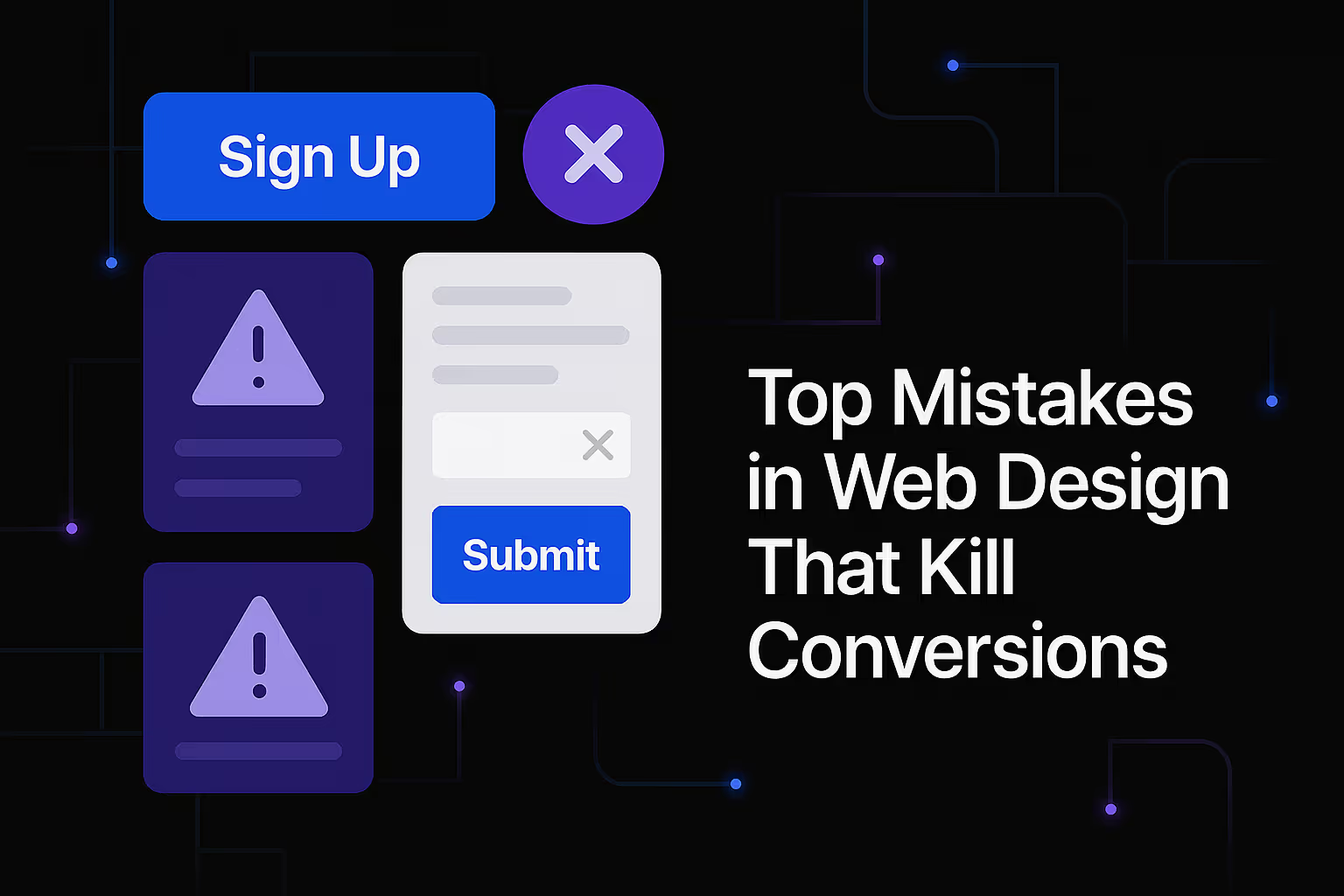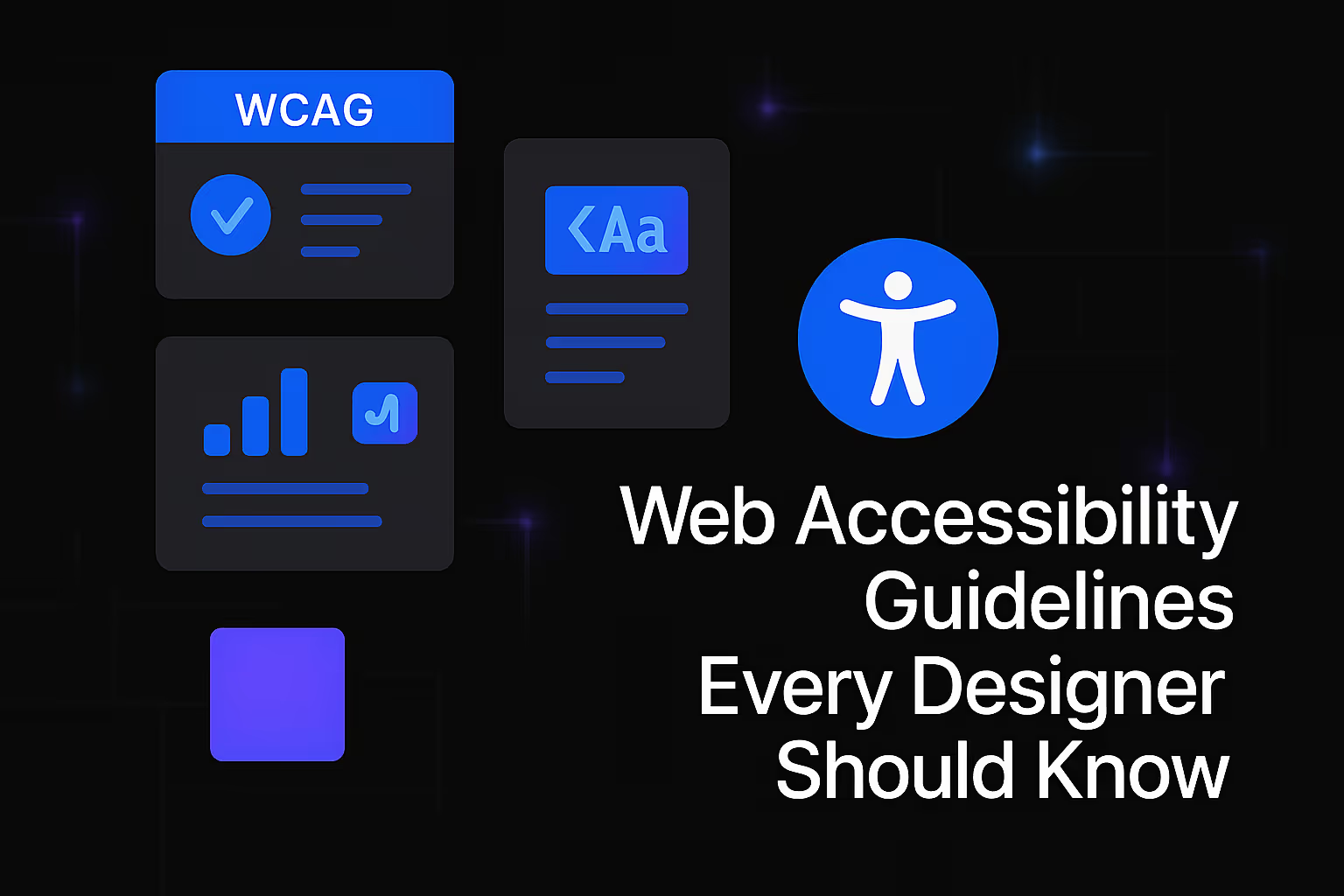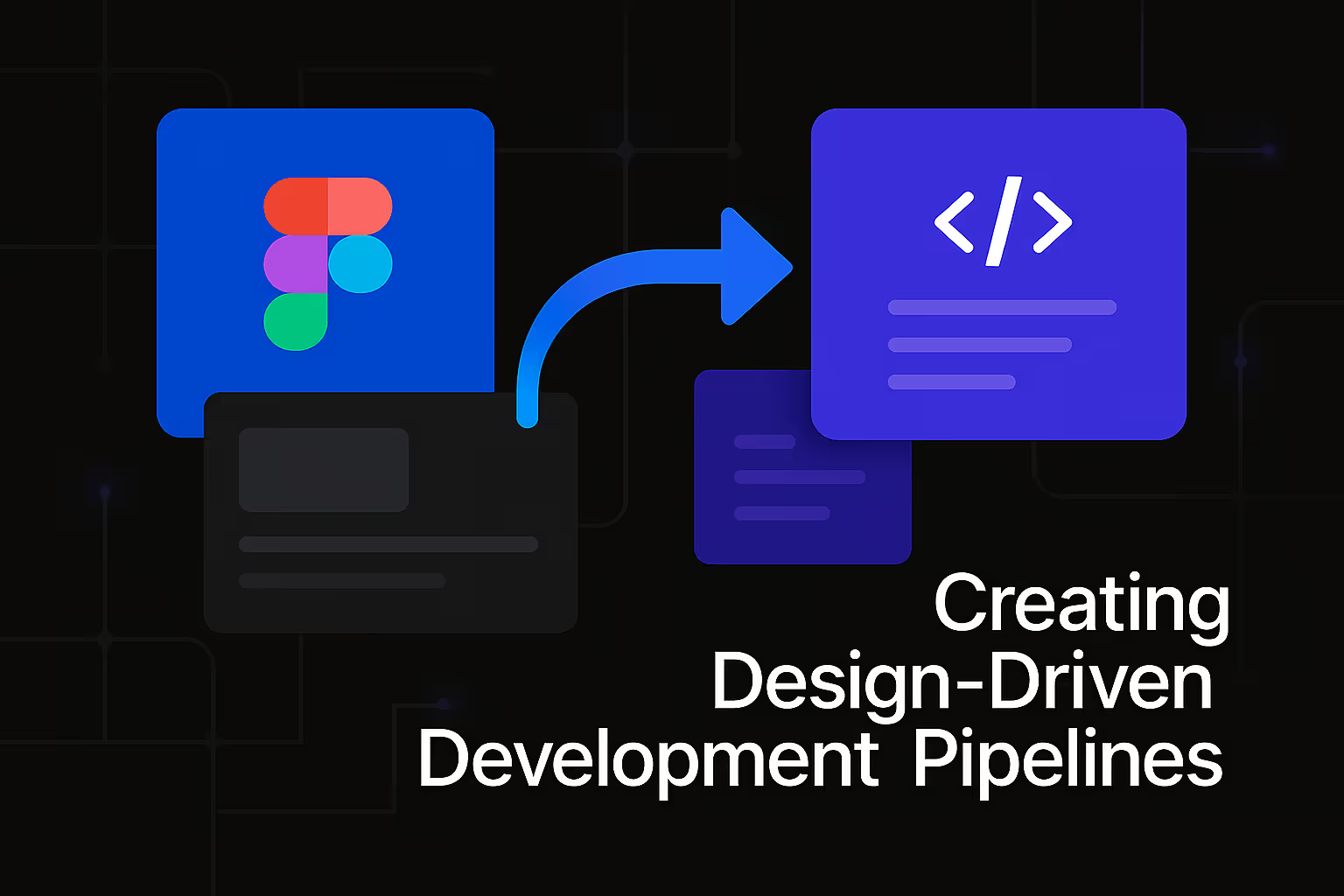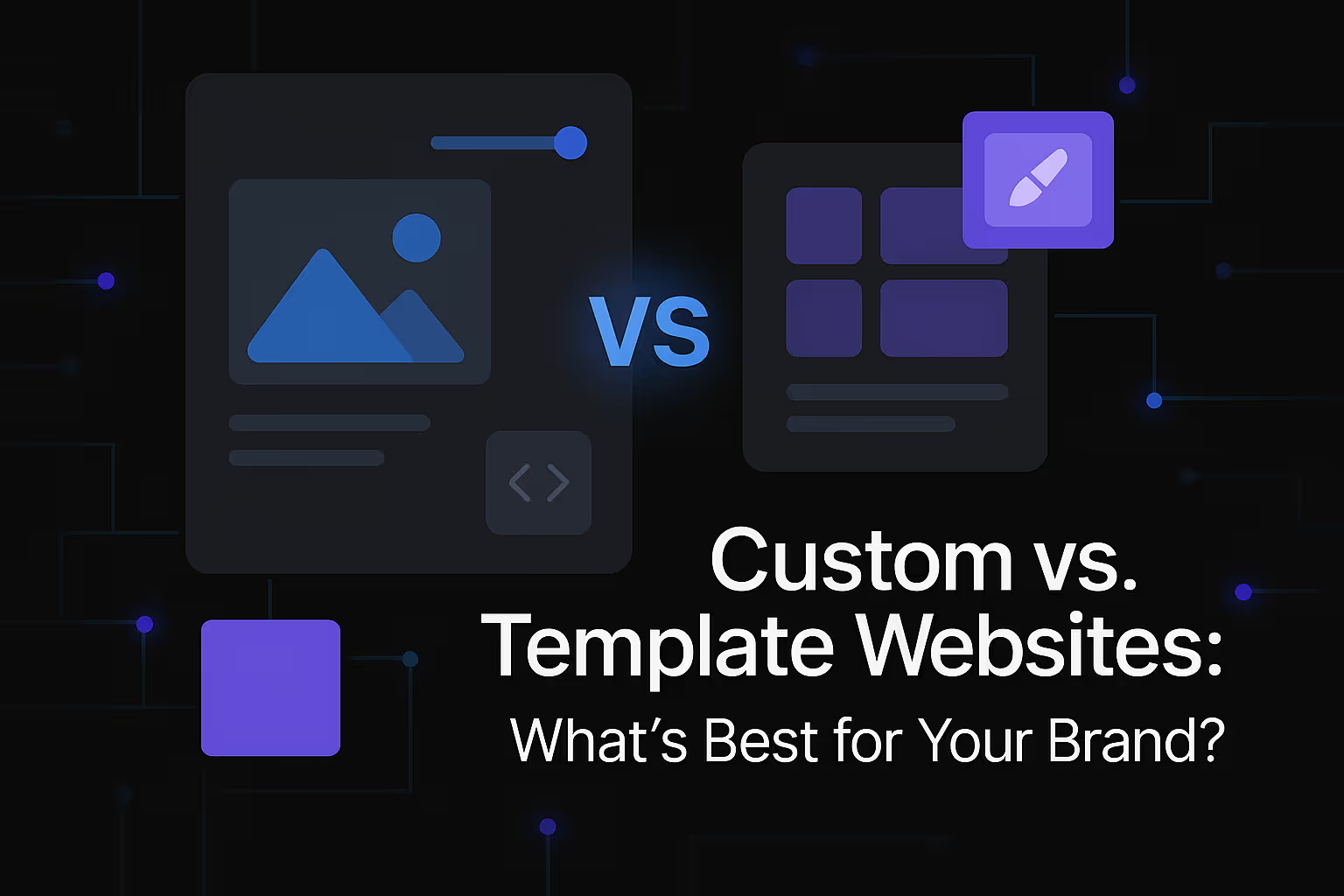Top Mistakes in Web Design That Kill Conversions

In the dynamic digital landscape, a website is far more than just an online brochure; it is often the primary engine of a business’s growth, a crucial touchpoint for engagement, and, most importantly, a powerful tool for driving conversions. Whether your goal is to generate leads, sell products, secure subscriptions, or simply encourage user interaction, your website's design plays an unparalleled role in achieving these objectives. A well-designed site effortlessly guides visitors towards desired actions, fostering a sense of trust and facilitating a seamless user journey. Conversely, even minor missteps in web design can act as significant roadblocks, turning potential customers away and effectively killing conversion rates.
Many businesses invest heavily in digital marketing efforts—from robust SEO strategies to targeted advertising campaigns—only to find their efforts fall flat when visitors land on a poorly optimized site. The journey from initial click to desired conversion is delicate, and every element of your web design, from layout to loading speed, from content presentation to call-to-action placement, either aids or obstructs this critical path. This comprehensive exploration delves into the most prevalent and detrimental web design mistakes that consistently sabotage conversion rates, offering insights and actionable advice to transform your digital presence into a conversion-generating powerhouse. Understanding these pitfalls is the first step toward building a website that truly performs.
The Pitfall of Poor User Experience (UX)
User experience, or UX, is the bedrock of any successful website. It encompasses every interaction a user has with your site, influencing their perceptions, emotions, and ultimately, their decision to convert. A poor UX is arguably the most significant conversion killer, as it directly frustrates and discourages visitors, leading them to abandon your site in favor of competitors.
Cluttered Layouts and Information Overload
Imagine walking into a physical store where products are haphazardly piled, aisles are jammed, and signs are confusing. You would likely leave without making a purchase. The same principle applies to web design. A cluttered website, brimming with too much text, excessive imagery, flashing banners, and an overwhelming array of options, creates immediate cognitive overload for the visitor. When users are bombarded with information, they struggle to identify what is important, where to look, or what action to take. This often results in a high bounce rate, as visitors quickly become disoriented and frustrated, unable to find the information they seek or the path to conversion.
Effective web design prioritizes clarity and simplicity. This means employing ample white space, which allows elements on the page to breathe and improves readability. It involves a hierarchical presentation of information, guiding the user’s eye naturally through the content. Key messages and calls to action should stand out, not get lost in a sea of distractions. Striking the right balance between providing sufficient information and avoiding overwhelming detail is crucial. Remember, less is often more when it comes to visual complexity and content density, especially on landing pages designed for specific conversions. Each element on the page should serve a clear purpose, contributing to the user’s understanding and guiding them towards the intended conversion goal.
Confusing or Non-Intuitive Navigation
Navigation is the map of your website, guiding visitors through its various sections and helping them find what they need. If this map is unclear, broken, or illogical, users will inevitably get lost and quickly exit your site. Confusing navigation is a classic conversion killer because it prevents users from reaching conversion-oriented pages such as product listings, service descriptions, contact forms, or checkout processes. Common mistakes include overly complex menus, inconsistent navigation elements across different pages, hidden menus that are difficult to discover, or using jargon instead of clear, universally understood labels.
An intuitive navigation system is paramount for a positive user experience. This means employing clear, concise, and descriptive labels for menu items. The navigation structure should be logical, reflecting how users typically think about your offerings. Dropdown menus should be used judiciously to organize categories without overwhelming the user. A persistent, easily accessible navigation bar at the top or side of the page ensures that users can always orient themselves. Furthermore, incorporating a search bar is highly beneficial, especially for content-rich websites, allowing users to quickly locate specific information. The goal is to make the user’s journey as effortless as possible, removing any friction that might deter them from exploring your site and ultimately converting.
Neglecting Mobile Responsiveness
In an era where smartphones and tablets dominate internet access, failing to optimize your website for mobile devices is not merely a mistake; it is a critical oversight that can decimate your conversion rates. A non-responsive website displays poorly on smaller screens, forcing users to pinch, zoom, and scroll excessively, creating an incredibly frustrating experience. This directly leads to high bounce rates from mobile users and sends a clear signal to search engines that your site is not providing a good user experience, negatively impacting your SEO rankings. With Google's mobile-first indexing, a site's mobile performance directly influences its visibility in search results.
Mobile responsiveness is no longer an option but a fundamental requirement for modern web design. Your website must seamlessly adapt its layout, images, and content to fit any screen size, providing an optimal viewing and interaction experience across all devices. This means ensuring that buttons are large enough to tap, text is legible without zooming, forms are easy to fill out, and navigation is straightforward on a mobile interface. Investing in a responsive design or a dedicated mobile version of your site is critical for capturing and converting the vast audience accessing the internet via mobile devices. Ignoring this essential aspect is equivalent to closing your doors to a significant portion of your potential customer base, directly hindering your ability to achieve conversion goals.
The Detriment of Slow Page Load Times
In our fast-paced digital world, patience is a dwindling commodity. Studies consistently show that even a delay of a few seconds in page load time can lead to a significant increase in bounce rates and a corresponding drop in conversions. Users expect instant gratification; if your site takes too long to load, they will abandon it before they even see your content, let alone engage with your calls to action. This issue is particularly exacerbated on mobile devices, where internet speeds can be less consistent.
Slow page load times can stem from various factors, including unoptimized images, excessive use of large files (videos, animations), poorly coded themes or plugins, reliance on too many external scripts, and inefficient server responses. Not only does this directly impact user experience and conversions, but it also has a substantial negative effect on your SEO. Search engines prioritize fast-loading websites, as they understand that speed is a critical factor in user satisfaction. A slow site will be penalized in search rankings, making it harder for potential customers to even find your site in the first place.
Optimizing page speed requires a multi-faceted approach. This includes compressing images without compromising quality, leveraging browser caching, minimizing CSS and JavaScript files, reducing server response times, and using a Content Delivery Network (CDN) to serve content faster to users globally. Regularly auditing your website's performance using tools like Google PageSpeed Insights can help identify specific areas for improvement. Prioritizing page speed optimization is not just a technical task; it is a strategic imperative for improving user experience, enhancing SEO, and ultimately boosting your conversion rates. Every second shaved off your load time can translate directly into more engaged users and more successful conversions.
The Absence or Weakness of Clear Calls to Action (CTAs)
A website's primary purpose, from a business perspective, is to guide visitors toward a desired action. This action, whether it's making a purchase, signing up for a newsletter, downloading an e-book, or requesting a demo, is facilitated by a Call to Action (CTA). One of the most common and damaging web design mistakes is the absence of clear, compelling CTAs, or their ineffective presentation. Without a clear directive, users are left wondering what to do next, leading to confusion and inaction, effectively halting the conversion process.
Mistakes in CTA design include burying them within text, using generic or uninspiring language, making them visually indistinct from other page elements, or placing them in areas where users are unlikely to see them. A CTA should be visually prominent, using contrasting colors that make it stand out, a distinct button shape, and strategic placement above the fold or at logical points within the content flow. The language used in a CTA is equally important. Instead of vague phrases like "Click Here," use action-oriented, benefit-driven language such as "Get Your Free Quote," "Download the Guide Now," or "Shop Our Latest Collection." This clarity not only tells the user what to do but also conveys the value they will receive by taking that action.
Furthermore, consider the user’s journey and context when placing CTAs. A general "Contact Us" button might be suitable for informational pages, but a product page demands a clear "Add to Cart" or "Buy Now" button. Landing pages, designed specifically for a single conversion goal, should have a dominant and singularly focused CTA. Effective CTAs are not just about aesthetics; they are the direct bridge between a visitor's interest and their decision to convert. By carefully crafting and strategically placing your CTAs, you provide the necessary guidance for users to take the desired next step, directly influencing your conversion performance.
Ignoring Search Intent and SEO Fundamentals
Many beautiful websites fail to generate conversions simply because they aren't built with search intent and fundamental SEO principles in mind. You can have a visually stunning site, but if potential customers cannot find it through search engines, or if the content on your pages doesn't align with what users are actually looking for, your conversion opportunities will be severely limited. This mistake often manifests as content that speaks at the user rather than to their needs, or a site structure that is impenetrable to search engine crawlers.
The core of this issue lies in neglecting keyword research and understanding the various types of search intent: informational (seeking knowledge), navigational (finding a specific site), transactional (looking to buy), and commercial investigation (researching before a purchase). If a user is performing a transactional search, landing on a page filled with only informational content without a clear path to purchase will lead to frustration and abandonment. Similarly, if your website lacks proper headings, meta descriptions, alt text for images, and a logical site structure, search engines will struggle to understand your content's relevance, reducing your visibility.
To overcome this, every page on your website should be strategically planned with specific keywords and user intent in mind. Your content should directly answer the questions or fulfill the needs of your target audience. Use H1, H2, and H3 headings effectively to structure your content, making it scannable for both users and search engines. Integrate relevant keywords naturally within your content, ensuring readability. Optimize your title tags and meta descriptions to be compelling and include primary keywords, encouraging higher click-through rates from search results. A website that is both aesthetically pleasing and search engine optimized is far more likely to attract qualified traffic that is ready to convert. By aligning your web design and content strategy with how users search, you significantly increase the chances of converting organic traffic into valuable leads and sales.
Inadequate Content Strategy and Poor Copywriting
Even with excellent design and perfect technical SEO, a website will struggle to convert if its content is unengaging, unclear, or fails to address the user's needs and concerns. This mistake encompasses several aspects: thin or generic content, poorly written copy riddled with errors, content that isn't tailored to different stages of the buyer’s journey, and a lack of compelling storytelling. Visitors come to your site seeking solutions, information, or entertainment; if your content doesn't deliver, they will quickly look elsewhere.
Generic content that merely describes features without highlighting benefits often falls flat. Users want to understand how your product or service will solve their problems or improve their lives. Similarly, dry, academic, or jargon-filled language can alienate potential customers. Good copywriting is persuasive, engaging, and empathetic. It speaks directly to the reader, acknowledges their pain points, and presents your offerings as the ideal solution. Spelling and grammatical errors, while seemingly minor, can severely undermine your credibility and professionalism, leading users to question the quality of your products or services.
Developing a robust content strategy is essential. This involves mapping out the types of content needed for different stages of the customer funnel—from awareness to consideration to decision. Provide valuable information, answer common questions, address objections, and build trust through informative blog posts, detailed product descriptions, compelling case studies, and transparent FAQ sections. The content should not only inform but also guide the user towards conversion. Each piece of content on your website should have a clear purpose and contribute to the overall conversion journey. By investing in high-quality, targeted, and well-written content, you can educate, persuade, and ultimately convert more visitors into loyal customers.
Trust and Credibility Issues
In the online world, trust is a precious commodity. If visitors perceive your website as untrustworthy, unprofessional, or insecure, they will hesitate to provide personal information, make purchases, or engage further. This can manifest in various ways, all of which act as significant conversion barriers. Common trust issues stem from outdated design, a lack of security indicators, missing contact information, absence of social proof, or even simply a generic, unbranded appearance.
An outdated or poorly maintained website can signal a lack of attention to detail or even that the business itself is no longer active or reliable. Users are more likely to trust a modern, clean, and professionally designed site. Security is paramount, especially for e-commerce sites or those collecting sensitive data. The absence of an SSL certificate (indicated by "https://" in the URL and a padlock icon) immediately raises red flags. Transparency is another key component of trust. Easily accessible contact information (phone number, email, physical address if applicable), clear privacy policies, and terms of service build confidence.
Furthermore, social proof plays a powerful role in building credibility and encouraging conversions. This includes displaying customer testimonials, reviews, case studies, trust badges (e.g., industry certifications, payment processor logos), and media mentions. These elements provide independent validation that your business is reputable and your offerings are valuable. For instance, prominently featuring positive customer reviews near a product description or a conversion form can significantly sway a hesitant buyer. By consciously integrating elements that foster trust and demonstrate credibility, your web design moves beyond mere aesthetics to actively reassure visitors and pave the way for successful conversions.
Ignoring Analytics and A/B Testing
One of the most profound mistakes in web design that kills conversions is the failure to continuously analyze performance data and conduct A/B testing. Many businesses launch a website and then assume their work is done, or they make design decisions based on intuition rather than empirical evidence. This "set it and forget it" mentality is a recipe for stagnation in the ever-evolving digital landscape. Without understanding how users are interacting with your site and why they are or are not converting, you cannot effectively optimize your design for better results.
Web analytics tools, such as Google Analytics, provide invaluable insights into user behavior: which pages they visit, how long they stay, their navigation paths, and where they exit. By examining metrics like bounce rate, conversion rate, time on page, and exit pages, you can pinpoint specific areas of your website that are underperforming. For example, a high bounce rate on a landing page might indicate issues with content relevance or a confusing layout, while a drop-off at a particular stage of a checkout process suggests friction in that step.
However, identifying problems is only half the battle. A/B testing (or split testing) allows you to test different versions of a web page element—such as a headline, image, CTA button color, or form layout—to see which performs better in terms of conversions. By sending a portion of your traffic to version A and another portion to version B, you can scientifically determine which design choices resonate more effectively with your audience. This iterative process of hypothesis, testing, analysis, and implementation is crucial for continuous improvement. Ignoring analytics and A/B testing means missing out on crucial opportunities to refine your user experience, eliminate conversion barriers, and incrementally boost your website's performance. It ensures your web design evolves based on real user data, leading to sustained and maximized conversion rates.
The Overlooked Elements: Forms, Pop-ups, and Multimedia
Beyond the major structural and content mistakes, several specific elements, if mishandled, can also significantly impact conversion rates. These often appear minor but can create disproportionate friction for users.
Overly Complex or Lengthy Forms
Forms are often the final gateway to a conversion, whether it's a contact form, a lead generation form, or a multi-step checkout process. A common mistake is making forms excessively long or overly complex. Every additional field you ask a user to fill out increases friction and decreases the likelihood of completion. Users are generally reluctant to share more information than is absolutely necessary, especially early in the conversion funnel. Forcing them to navigate multiple pages or fill out irrelevant fields can lead to high abandonment rates.
To optimize forms for conversions, strive for minimalism. Only ask for the essential information required to fulfill the specific conversion goal. If a form is inherently long, break it down into logical, digestible steps, clearly indicating progress to the user. Use clear field labels, provide helpful error messages, and utilize auto-fill features where appropriate. Consider the psychological barrier of asking for too much upfront; sometimes, collecting less information initially can yield more conversions, with the option to gather more data later. Streamlining your forms makes the conversion process smoother and less daunting, directly improving completion rates.
Intrusive or Annoying Pop-ups
Pop-ups, when used strategically, can be effective for lead generation or promoting offers. However, when deployed poorly, they become one of the most annoying and conversion-killing elements on a website. Intrusive pop-ups that appear immediately upon arrival, cover the entire screen, are difficult to close, or appear too frequently can severely disrupt the user experience. They interrupt the user's flow, distract them from the main content, and often lead to immediate site abandonment. Google also penalizes mobile websites with interstitial pop-ups that obscure content.
Effective pop-ups are non-intrusive and contextually relevant. Consider using exit-intent pop-ups that trigger only when a user appears to be leaving the site, or timed pop-ups that appear after a user has engaged with content for a certain duration. Ensure they are easy to dismiss and that their content offers genuine value—a discount, a valuable guide, or an exclusive offer. The key is to enhance, not hinder, the user's journey. A well-timed, value-driven pop-up can capture leads without alienating your audience, but a poorly implemented one will undoubtedly drive away potential conversions.
Unoptimized or Autoplaying Multimedia
While images and videos can significantly enhance a website's appeal and convey information effectively, their improper use can severely impede conversions. Unoptimized images that are too large in file size contribute directly to slow page load times, a major conversion killer we've already discussed. Beyond size, images that are irrelevant, low-quality, or stock photos that lack authenticity can detract from credibility.
Autoplaying videos with sound are perhaps one of the most universally disliked web design elements. They create an immediate sense of annoyance and disrupt the user's control over their browsing experience, often leading them to close the tab rather than find the mute button. This jarring experience is a quick way to lose a potential conversion.
To avoid these pitfalls, ensure all images are compressed and properly formatted for web use, utilizing appropriate alt text for SEO and accessibility. Use high-quality, relevant imagery that supports your message and brand identity. For videos, provide clear play controls, always default to muted, and offer transcripts where possible for accessibility and SEO. Multimedia should enhance the user experience and support the conversion journey, not detract from it. When used thoughtfully, images and videos can clarify complex concepts, build emotional connections, and ultimately facilitate conversions.
Conclusion: Designing for Conversion, Not Just Aesthetics
Building a website that looks good is a commendable first step, but a truly successful website is one that actively converts visitors into customers, leads, or subscribers. As we have explored, the journey from website visitor to converted user is fraught with potential pitfalls, many of which stem from common web design mistakes. From the foundational aspects of user experience and page speed to the strategic integration of clear calls to action and a keen understanding of search intent, every element contributes to or detracts from your conversion potential.
Ignoring mobile responsiveness in an increasingly mobile-first world is akin to ignoring a vast segment of your audience. Allowing your site to load slowly will test the patience of even the most interested visitors, often to the breaking point. Failing to provide clear direction through compelling CTAs leaves users adrift, unsure of the next step. Neglecting SEO fundamentals means your perfectly designed site might remain invisible to those who need it most. Furthermore, a weak content strategy, unaddressed trust issues, complex forms, intrusive pop-ups, and unoptimized multimedia all chip away at the visitor’s willingness to convert.
The key to overcoming these conversion killers lies in a holistic and user-centric approach to web design. It requires continuous analysis of performance data, a commitment to A/B testing, and an unwavering focus on the user’s journey. Your website should be a seamless, intuitive, and trustworthy environment that anticipates user needs, addresses their concerns, and effortlessly guides them towards conversion goals. By systematically addressing these common web design mistakes, you can transform your website from a passive online presence into a dynamic, conversion-generating asset, unlocking its full potential and driving sustainable business growth. Embrace the mindset of constant optimization, and watch your conversion rates soar.
Similar Insights
Stay Updated with Our Insights
Join our newsletter for the latest trends and tips in web development and digital marketing.




